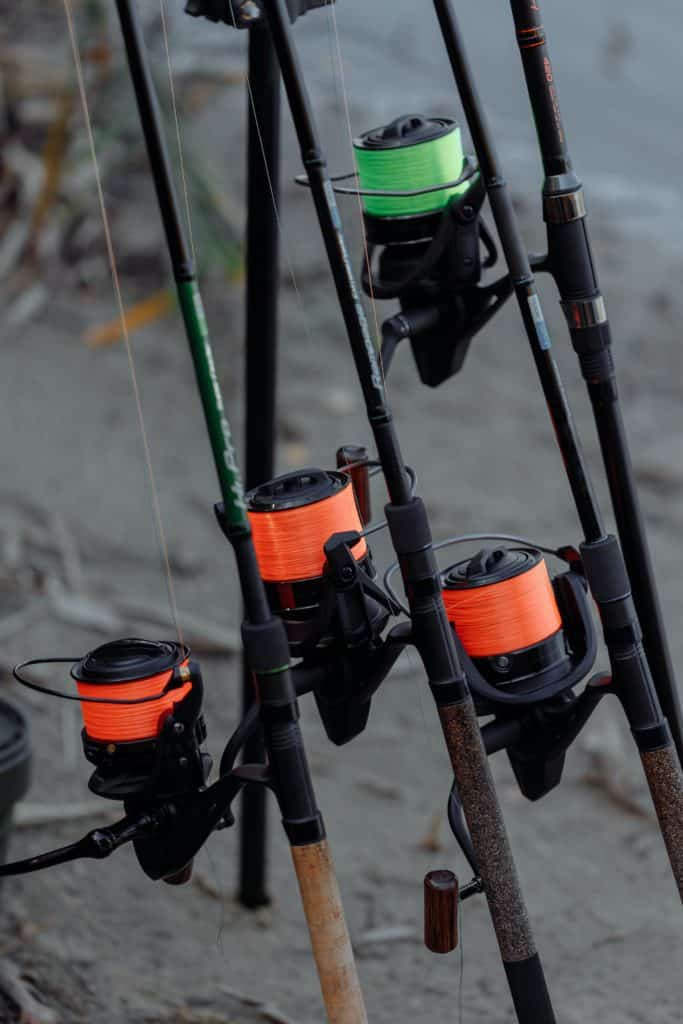Let’s face it, it’s way too easy to overcomplicate bank fishing. You see all the videos of the guys carrying ten rods, 100 pounds of tackle, and six cans of Monster. Below, we focus on drilling it down to the basics. A personal mantra I constantly have to force myself into is this: “Keep it simple stupid”.
The Essential Gear for Bass Bank Fishing
1. Rods and Reels: In the realm of bank fishing for bass, versatility is key. Spinning gear, such as a medium-heavy spinning rod in the 7-foot range paired with a quality reel, is a staple for most anglers. Additionally, a baitcasting combo is a great pairing, as it offers more control and precision. For the baitcaster, I recommend a 7-foot range Medium Heavy, fast action rod. These two combos will cover most applications you will run across while bank fishing while still keeping you mobile.
2. Fishing Line: Monofilament line in the 10 to 20-pound range is a solid choice for bank fishing on a budget. It is strong and easy to handle, making it perfect for when you inevitably snag a lure. It is also a very versatile line, as you can use it for both topwater and weighted applications.
3. Lures: The world of lures is vast, so variety is your ally. Stock up on topwaters, crankbaits, jigs, soft plastics, and spinners. Different lures work at different times, so keeping an assortment in your bag will serve you well. However, mobility is key in the realm of bank fishing. Carrying too much tackle becomes cumbersome, especially if you are like me and like to go plunging through the trees.
4. Terminal Tackle: This category covers your hooks, weights, and various jig heads. For bass fishing, wide gap hooks and bullet weights for Texas-rigged plastics are always a good start. As a hot tip, carrying a few bobbers can come in handy when the bass aren’t biting and you have to call an audible to catching some slab crappies!
5. Tackle Bag: Unlike a rigid tackle box, a tackle bag is often more portable and easier to carry when bank fishing. They come with plenty of compartments for efficient organization of your gear. Choose a bag that is durable and waterproof to keep your tackle safe. For a very budget friendly alternative, I recommend the Bass Pro Qualifier 360. At the time of this post, it clocks in around $30 and takes a beating.
Bank Fishing Tips and Tricks
Now that we’ve got the gear covered, let’s dive into some strategic tips to maximize your success while bank fishing for bass.
1. Location is Key: Just like in real estate, it’s all about location, location, location. Look for spots with natural structures like downed trees, boulders, or areas with a drop-off. These are the areas where bass tend to congregate.
2. Timing Matters: Early morning and late evening are prime feeding times for bass. Plan your fishing trips around these times to increase your chances of a catch.
3. Be Stealthy: Since you’re closer to the fish, movements and noise can scare them off. Approach your chosen spot slowly and quietly to avoid spooking those bucket largemouth.
4. Watch the Weather: Bass behavior changes with the weather. On cloudy days, they are more likely to be feeding near the surface. On sunny days, they will likely retreat to deeper waters or near structures for cover.
5. Practice Catch and Release: While it might be tempting to take your catch home, consider practicing catch and release. This helps to maintain healthy fish populations and contributes to the sustainability of the sport.
Remember, the goal isn’t to bring your whole garage to the water. The objective is being mobile, finding the right spots, and catching the big ole girl that the guy in the $70k bass boat missed half an hour ago.
Tight lines,
Dawson

Pingback: The Ultimate Guide to Texas Rigging for Big Bass | Tackle Box Tactics